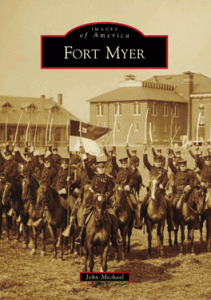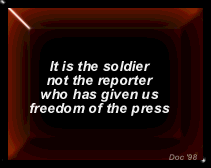The Historic US Army Forts! Part II
Over the past two decades, John Michael has immersed himself in the study of the US military, specifically the US ARMY. Today’s ARMY is a far cry from what was a hundred years ago. As the United States population pushed west, many US Army posts emerged to provide protection and safety to what was once wilderness and danger. John Michael is the author of books that chronicle the history of two of these forts = Fort Myer and Fort Lesley J. McNair. Many other authors have seen the value in documenting and chronicling this unique military history. So without further rambling, here is the first installment of books for your personal library shelf or as gifts for someone special.
Intrigued by the past? Need a great collection of books for your library or kindle? Then there are several selections to choose from
Fort Leavenworth (Images of America)
by
ABOUT THE BOOK:
On March 17, 1827, Col. Henry Leavenworth received orders from Washington. Along with four companies of the 3rd Infantry Regiment, he departed from the Jefferson Barracks at St. Louis, traveled up the Missouri River, and selected a site for a permanent settlement. Cantonment Leavenworth was established on May 8, 1827, and renamed Fort Leavenworth on February 8, 1832. Since then, it has grown and met the demands of the U.S. Army. From the protection of pioneers along the Santa Fe Trail to peacekeeping missions among the Native Americans, the fort’s role in the nation’s expansion westward is second to none. Fort Leavenworth has continually reinvented itself to meet the challenges facing the nation. From training units during the Civil War to army education during Operation Enduring Freedom, the fort’s many schools have stood true to their motto: Ad Bellum Pace Parati (prepared in peace for war).
++++++++++++++++++++++++++++++++++++++++++++++++++++++++++++++
Old Fort Jackson (Images of America)
by Laura Seifert (Author)
ABOUT THE BOOK:
Fort James Jackson has been the silent sentinel protecting Savannah, Georgia, for over 200 years. Never taken by force, its soldiers also never fired a shot in anger, only in celebration. On Halloween in 1863, Confederate President Jefferson Davis received a 21-gun salute while touring the Savannah River defenses on the steamer Beauregard. However, the soldiers at the fort faced many challenges, including disease, cold, heat, mosquitoes, poor nutrition, and stress. Active during wartimes, the fort was often quietly abandoned between wars. Union soldiers last fired the fort’s guns on April 11, 1865, when Savannah got news of the fall of Richmond and the war’s end. After the Civil War, the fort’s longest wait began, despite 1870s renovation attempts. The mid-1960s saw renewal through historic preservation and archaeology as the fort became a museum. The fort was even a filming location for the movie Glory, which was appropriate as the 55th Massachusetts Infantry Regiment, an African American unit, was briefly stationed here.
++++++++++++++++++++++++++++++++++++++++++++++++++++++++++++++
Fort McHenry
and
Baltimore’s Harbor Defenses (MD)
(Images of America)
by Merle T. Cole (Author), Scott S. Sheads (Author)
ABOUT THE BOOK:
Few residents or visitors to the Baltimore metropolitan area understand the strange concrete structures they routinely pass when crossing the Francis Scott Key Bridge or glimpse while fishing or boating in the Patapsco River, but the treasured heritage associated with these noble structures is a part of our collective past. Fort McHenry and Baltimore’s later harbor defenses played significant roles in our nation’s evolving military history and in the greater American drama. Many books have celebrated the defense of Fort McHenry during the War of 1812 and the birthplace of our national anthem, but no other provides the wealth of imagery contained within these pages. The fort’s military history from its construction through the British bombardment, the Civil War, and two World Wars, as well as its unique status as the only fort to be designated a National Monument and Historic Shrine, are explored through the valuable visual record that remains. Following the Civil War, when advances in technology had rendered brick forts such as Fort McHenry obsolete, the United States Army constructed three forts- Fort Armistead, Fort Smallwood, and Fort Howard-and renovated a fourth – Fort Carroll – to protect Baltimore’s harbor. The architecture, weapons, daily life of soldiers, and changing military uses of Fort McHenry and these “modern” forts, some of which now serve as waterfront parks, are the focus of this illustrated retrospective.
++++++++++++++++++++++++++++++++++++++++++++++++++++++++++++++


Fort Clark
and
Brackettville: Land of Heroes (TX)
(Images of America)
by Bill Haenn (Author)
ABOUT THE BOOK:
The story of Fort Clark and Brackettville began with a quiet pool of water, Las Moras Spring, named by the Spanish conquistadors for the mulberry trees lining its banks. The discovery of gold in California and the Treaty of Guadalupe Hidalgo precipitated the opening of the Lower Road from San Antonio to El Paso. To protect the spring and the travelers on the road, the U.S. government established a fort on the high ground above the spring. The town of Brackettville grew with the fort, and the area soon played host to an honor roll of American heroes. Revealed in some 200 images, many never before published, are some of the fort’s most famous alumni, including Stuart, Longstreet, Sheridan, Sherman, Bullis, Patton, and Wainwright, in addition to the little-known Medal of Honor recipients buried there. Captured here are the deeds of a legion of unsung heroes, as well as the fort and town’s historic past, highlighting the Indian War era, the Seminole Scouts, and the quiet time between the World Wars. Culled from the collections of the Library of Congress, the National Archives of the U.S. Army Signal Corps, and pioneer photographer Eugene O. Goldbeck, this book is a testament to American soldiers throughout the country.
++++++++++++++++++++++++++++++++++++++++++++++++++++++++++++++

Fort Hood
in World War II
(Images of America)
by
ABOUT THE BOOK:
On January 14, 1942, Col. Andrew D. Bruce announced that the location of the new Tank Destroyer Tactical Training and Firing Center was to be near Killeen, Texas. This announcement put into motion a whirlwind of activity and construction that resulted in the creation of one of the largest military bases in the world. On September 18, 1942, Camp Hood was officially opened. Eight short months after the opening of Camp Hood, the base nearly doubled in size. Building from scratch, the spirit of a black panther, as depicted on the tank destroyers shoulder patch, was channeled into anti-tank combat teams. These teams were trained to fight the formidable might of Germany’s panzer divisions.
++++++++++++++++++++++++++++++++++++++++++++++++++++++++++++++
World War II
in Fort Pierce
(Images of America: Florida)
by Robert A. Taylor (Author)
ABOUT THE BOOK:
Few Florida communities felt the impact of World War II as much as the Atlantic-coast town of Fort Pierce. With a population that soared along with its economy, the small city made an important contribution to Allied victory by hosting a major military training base. Prior to that, the war had come only as close as the German submarines stalking targets off the southern coast of the peninsula. In 1943, however, the U.S. Navy commissioned its newest
amphibious training base in Fort Pierce, and tens of thousands of young men would eventually prepare for combat on the town’s sunny shores. The intensive physical and mental training was hardly “a day at the beach,” and within a few months, Fort Pierce had become a major military post with a national reputation. It also became the training site of some of the most elite units of the armed forces, including the Scouts and Raiders, U.S. Army Rangers, and the legendary “frogmen.”
++++++++++++++++++++++++++++++++++++++++++++++++++++++++++++++
The United States Army
at Fort Knox (KY)
(Images of America)
by Matthew D. Rector (Author)
ABOUT THE BOOK:
Located in north-central Kentucky, Fort Knox is one of the army’s major installations and is home to several commands, including the United States Army School and Center and the United States Army Recruiting Command. The fort’s history dates to 1903, when a series of military maneuvers was held by the United States Army in West Point, Kentucky. When World War I required the establishment of additional military training facilities, Camp Knox was created. The post closed as a permanent installation in 1922, but it remained an active training center for army programs and, briefly, a national forest. On January 1, 1932, Camp Knox was made a permanent installation again and has since been known as Fort Knox. In 1940, the Armored Force was established, paving the way for the continuing evolution of armed warfare. The United States Bullion Depository chose its location because of its proximity to this post.
++++++++++++++++++++++++++++++++++++++++++++++++++++++++++++++
The United States Disciplinary Barracks
by Peter J. Grande (Author)
ABOUT THE BOOK:
On May 21, 1874, Congress approved the establishment of the United States Disciplinary Barracks (USDB), formerly the United States Military Prison at Fort Leavenworth. The original prison was once a quartermaster depot, supplying all military posts, camps, and stations in the Indian Territory to the West. It has been the “center of correctional excellence” in the military for over 130 years, housing the most notorious service members in the armed forces, including maximum-custody inmates and those with death sentences. On October 5, 2002, retreat was played for the last time in front of the eight-story castle inside the old USDB, and another era started with the occupation of a new modern correctional facility.
++++++++++++++++++++++++++++++++++++++++++++++++++++++++++++++













Pingback: The Historic US Army Forts - John Michael Creatives